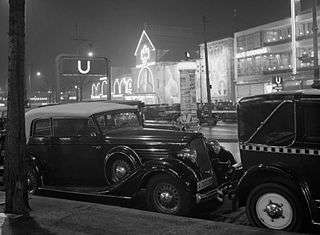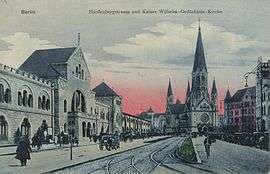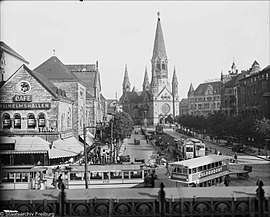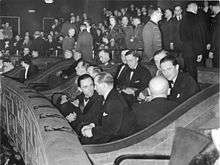Ufa-Palast am Zoo
The Ufa-Palast am Zoo, located near Berlin Zoological Garden in the New West area of Charlottenburg, was a major Berlin cinema owned by Universum Film AG, or Ufa. Opened in 1919 and enlarged in 1925, it was the largest cinema in Germany until 1929 and was one of the main locations of film premières in the country. The building was destroyed in November 1943 during the Bombing of Berlin in World War II and replaced in 1957 by the Zoo Palast.

History

The Neo-Romanesque building at Hardenbergstraße was designed as an exhibition hall by architect Carl Gause (1851–1907), an alumnus of the Bauakademie who had also drawn plans for the Hotel Adlon. Like the Romanisches Haus nearby, the design followed the model of the Kaiser Wilhelm Memorial Church at Auguste-Viktoria-Platz (present-day Breitscheidplatz), built in 1891–1895 according to plans by Franz Schwechten. The development of a "Romanesque forum" met the demands of Emperor Wilhelm II who even set guidelines for the design of streetlights and tram power lines.[1] Construction work took place from 1905 to 1906; the building complex initially hosted the Ausstellungshallen am Zoologischen Garten exhibition halls, named after the adjacent Berlin Zoo.
In 1912, Arthur Biberfeld converted the western hall into a theatre. In 1913–15, projection facilities were installed by Oskar Kaufmann for the première of the film Quo Vadis, produced by the Italian Cines company, and from 1913 to 1914, the theatre was called the Cines-Palast.[2] The other section of the building housed a café and variety theatre called the Wilhelmshallen.[3]
In 1919, architect Max Bischoff rebuilt it for Ufa as a 1,740-seat cinema, which opened on 18 September 1919 with the première of Ernst Lubitsch's Madame Dubarry.[4][5] The cinema had a rectangular auditorium with two levels of proscenium boxes and the remaining seating arranged in horseshoe-shaped rows.[2] Siegfried Kracauer praised the sightlines from the amphitheatre-style seating and the "discreet" and "tasteful" colour scheme;[6] the décor was simple, with faïence panels around the screen.[2]
In 1925, the cinema was again rebuilt by Carl Stahl-Urach; it was enlarged to 2,165 seats by the addition of a balcony, the lighting was improved, and an illuminated cinema organ was added.[2][7] The interior décor by Samuel Rachman resembled that of Broadway cinemas.[8] It was the largest cinema in Germany until the 1929 opening of the Ufa-Palast in Hamburg, which was at that time the largest in Europe.

The reopening on 25 September 1925 was overseen by Ernö Rapée, a former employee of the American cinema impresario "Roxy" Rothafel who was brought over by Ufa together with Alexander Oumansky, who had been ballet director at Roxy's Capitol Theatre, to introduce US-style cinema shows to Germany. They were given an 85-member orchestra plus a jazz band, and Roxy himself came to offer assistance. The New York Times reported that the American "combination of symphony concert, ballet and film" had been successfully imported to Germany for the first time. Rapee stayed on for almost a year as manager and as Ufa's senior music director, in which role he arranged music to accompany several films; he left after supervising the opening of Ufa's new Gloria-Palast across the square.[9] Berlin's own Capitol cinema, designed by Hans Poelzig, also opened in 1925 as a nearby competitor to the Ufa-Palast;[10] by 1928, when Joseph Goebbels made a speech denouncing the entertainment and other business venues there, Berlin's premier cinemas were clustered close together around the Kaiser Wilhelm Memorial Church and some had deliberately sought to make it the "Broadway of Europe".[11]
Following the renovation, the exterior was used for advertising, designed by Ufa's scenic designer Rudi Feld. This began with light displays and large posters and progressed to complete transformations of the appearance of the building. For example, for Spione in 1928, a gigantic stylised eye stared out of the centre of the façade and the letters of the title, written across the whole width of the central bay, became pupils which emitted searchlights;[12][13] for Frau im Mond in 1929, the façade was draped in lights to evoke stars, and above the entrances skyscraper cities jutted out, from the centres of which model spaceships travelled to a moon globe and back;[14] and for Asphalt, also in 1929, a huge transparency of a street scene—taken from the credits—was mounted on the front of the building, with speeding cars in the foreground, and alternately lighted and darkened; wooden gates swung closed in front of it, with the title written on them in letters blazing with light.[15][16] The exception was Fritz Lang's Metropolis, which received a double première on 10 January 1927: the gala première at the Ufa-Palast am Zoo was attended by President Hindenburg but advertised only by a sign above the entrance reading Welturaufführung (world première), while the smaller première, primarily for the press, took place at the smaller Ufa-Pavillon am Nollendorfplatz (Germany's first purpose-built cinema, dating to 1912), which for the occasion was painted silver and illuminated "gleam[ing] like a beacon into the night", as a contemporary reviewer put it, and had a gong mounted over the main entrance; the film's brief German run continued there.[17][18][19][20]
Under the Nazis, for important occasions like the 1935 première of Leni Riefenstahl's Triumph des Willens and the March 1943 celebration of Ufa's own 25th anniversary, Albert Speer modified the façade[21] and it was dressed with large numbers of swastika flags spotlighted from below and with a huge eagle.[22][23] For the 1936 Summer Olympics in Berlin, Speer designed a false front in simplified classical style.[2][22] The following year, the remainder of the façade was similarly covered and heavy masonry pylons evoking the entrance to the Olympic Stadium set on either side of the entrance;[24] one architectural historian has noted that except for the lack of windows and the decoration with film posters rather than government symbols, the building then looked very like Speer's New Reich Chancellery.[25]
The building was destroyed by bombing on 23 November 1943. The Zoo Palast was built on the site in 1957.
Use for premières

The Ufa-Palast am Zoo was one of the main locations for film premières in Germany.[26][27] These included:
Premières under the Weimar Republic
- 18 September 1919: Madame Dubarry[4][5][28]
- 4 December 1919: Die Puppe[29]
- 14 December 1920: Anna Boleyn[30]
- 9 March 1920: Kohlhiesels Töchter[31]
- 1 September 1920: Sumurun[32]
- 29 October 1920: Der Golem, wie er in die Welt kam[33]
- 14 April 1921: Die Bergkatze[34]
- 22 October 1921: Das indische Grabmal (Part 1)[35]
- 19 November 1921: Das indische Grabmal (Part 2)[36]
- 27 April 1922: Dr. Mabuse, der Spieler (Part 1)[37][38]
- 26 May 1922: Dr. Mabuse, der Spieler (Part 2)[38]
- 13 November 1922: Phantom[39]
- 7 January 1924: Die Finanzen des Großherzogs[40]
- 14 February 1924: Die Nibelungen (Part 1)[38]
- 26 April 1924: Die Nibelungen (Part 2)[38]
- 23 December 1924: Der letzte Mann[41][42]
- 16 November 1925: Varieté[43]
- 14 October 1926: Faust[44]
- 17 December 1926: The Holy Mountain[45][46]
- 10 January 1927: Metropolis[38][47]
- 24 January 1927: Eine Dubarry von heute[48]
- 22 March 1928: Spione[49]
- 18 February 1929: Asphalt[15]
- 27 August 1929: Der Würger
- 15 October 1929: Frau im Mond[49]
- 17 September 1930: The Copper
- 11 May 1931: M[49]
- 31 August 1931: Bombs on Monte Carlo[50]
- 26 November 1931: Der Draufgänger
- 24 March 1932: Das blaue Licht[46][51][52]
- 8. August 1932: Quick
- 12 October 1932: Der schwarze Husar[53]
- 19 November 1932: Der weiße Dämon
- 22 December 1932: F.P.1 antwortet nicht
Premières in the Third Reich until the outbreak of World War II
- 2 February 1933: Morgenrot[54][55]
- 9 May 1933: Ein Lied geht um die Welt
- 15 August 1933: Ein gewisser Herr Gran
- 30 August 1933: S.O.S. Eisberg[46][56]
- 1 December 1933: Sieg des Glaubens[46][57][58]
- 8 December 1933: Flüchtlinge
- 29 March 1934: Gold[59]
- 12 March 1935: Artisten[60]
- 28 March 1935: Triumph des Willens[21][46]
- 19 November 1935: Frisians in Peril[61]
- 30 December 1935: Tag der Freiheit: Unsere Wehrmacht[46]
- 23 January 1936: Traumulus
- 10 July 1936: Weiberregiment
- 16 October 1936: Stadt Anatol[62]
- 23 December 1936: Unter heißem Himmel
- 15 July 1937: Der Mann, der Sherlock Holmes war[63]
- 20 August 1937: Alarm in Peking
- 19 October 1937: Der zerbrochene Krug
- 21 December 1937: Gasparone
- 6 January 1938: Der Berg ruft
- 11 February 1938: Der Tiger von Eschnapur
- 20 April 1938: Olympia[24][46]
- 26 February 1938: Das indische Grabmal
- 1 April 1938: Fünf Millionen suchen einen Erben
- 18 October 1938: Dreizehn Stühle
Premières during World War II
- 20 March 1940: Stern von Rio[64]
- 28 November 1940: Der ewige Jude[65]
- 6 December 1940: Bismarck[66]
- 30 December 1940: Wunschkonzert[67]
- 14 February 1941: Ohm Krüger[68]
- 12 June 1942: Die große Liebe[69]
- 5 March 1943: Münchhausen[27][70]
Gala premières following first showing elsewhere
- 15 November 1929: The White Hell of Pitz Palu[46][71]
- 19 September 1933: Hitlerjunge Quex[72]
- 23 September 1936: Der Bettelstudent
- 17 March 1939: Wasser für Canitoga
- 15 August 1939: Es war eine rauschende Ballnacht[73]
- 26 September 1939: Robert Koch, der Bekämpfer des Todes[74]
- 19 January 1940: Wir tanzen um die Welt[75][76]
- 24 September 1940: Jud Süß[77]
- 23 October 1941: Heimkehr[78][79]
The première of Fritz Lang's Das Testament des Dr. Mabuse, like those of his earlier films, was scheduled to be held at the Ufa-Palast am Zoo, on 23 March 1933, but was cancelled when the film was banned by the Nazis.[80][81]
References
- Romanisches Forum - Berlin.de (in German)
- Ehemaliger Ufa-Palast am Zoo, Lexikon: Charlottenburg-Wilmersdorf von A bis Z, Bezirksamt Charlottenburg-Wilmersdorf, City of Berlin, retrieved 19 December 2012 (in German)
- Rudolf Woelky, EIN ETWAS ERLEBT ETWAS: ... UND DAS WAR DAS LEBEN, Norderstedt: Books on Demand, 2010, ISBN 978-3842313354, p. 76 (in German)
- Klaus Kreimeier, trans. Robert and Rita Kimber, The Ufa Story: A History of Germany's Greatest Film Company, 1918–1945, 1996, repr. Berkeley: University of California, 1999, ISBN 978-0-520-22069-0, p. 56, referring to the film by its U.S. title, Passion.
- Marc Silberman, German Cinema: Texts in Context, Detroit: Wayne State University, 1995, ISBN 978-0814325605, p. 3.
- Cited in Sabine Hake, Passions and Deceptions: The Early Films of Ernst Lubitsch, Princeton, New Jersey: Princeton University, 1992, ISBN 978-0691031972, p. 119.
- Ken Roe, Ufa Palast am Zoo, Cinema Treasures, retrieved 20 December 2012.
- Victoria De Grazia, Irresistible Empire: America's Advance Through Twentieth-Century Europe, Cambridge, Massachusetts: Harvard-Belknap, 2005, ISBN 978-0674016729, p. 286.
- Ross Melnick, American Showman: Samuel "Roxy" Rothafel and the Birth of the Entertainment Industry, 1908–1935, Film and culture, New York: Columbia University, 2012, ISBN 978-0231159043, pp. 253–54.
- Michael Bienert and Elke Linda Buchholz, Die Zwanziger Jahre in Berlin: ein Wegweiser durch die Stadt, 2nd ed. Berlin: Berlin-Story, 2006, ISBN 978-3929829280, p. 208 (in German)
- Janet Ward, Weimar Surfaces: Urban Visual Culture in 1920s Germany, Weimar and now 27, Berkeley: University of California, 2001, ISBN 9780520222991, pp. 181–83.
- Ward, p. 171.
- Photo in Steven Heller, Mirko Ilić, The Anatomy of Design: Uncovering the Influences and Inspiration in Modern Graphic Design, Minneapolis, Minnesota: Quayside, 2009, ISBN 978-1592535545.
- Ward, p. 169, Fig. 41, p. 170.
- Ward, p. 157, Fig. 37. p. 158.
- Kreimeier, p. 117; photographs following p. 152.
- Aitam Bar-Sagi, "'Metropolis' around the World", The Film Music Museum, 6 November 2010, retrieved 23 December 2012.
- Ward, pp. 166–67, Figure 40 p. 168.
- Review in Der Kinematograph, 16 January 1927, in translation in: Michael Minden and Holger Bachmann (eds.), Fritz Lang's Metropolis: Cinematic Visions of Technology and Fear, Studies in German literature, linguistics, and culture, Rochester, New York: Camden House, 2000, ISBN 978-1571131225, pp. 82–83.
- "1927: Art & Culture", Starr Figura and Peter Jelavich, German Expressionism: The Graphic Impulse, exhibition catalogue, New York: Museum of Modern Art / Distributed Art, 2011, ISBN 978-0870707957, p. 280.
- Steven Bach, Leni: The Life and Work of Leni Riefenstahl, New York: Knopf, 2007, ISBN 978-0375404009, p. 138.
- Kreimeier, p. 254.
- Kreimeier, p. 322.
- Bach, Leni, p. 164.
- Kreimeier, p. 254, citing Dieter Bartetzko, Illusionen in Stein: Stimmungsarchitektur im deutschen Faschismus: ihre Vorgeschichte in Theater- und Film-Bauten, Rororo Sachbuch, Kulturen und Ideen, Reinbek bei Hamburg: Rowohlt, 1985, ISBN 978-3499178894.
- Stephen Brockmann, A Critical History of German Film, Studies in German Literature, Linguistics, and Culture, Rochester, New York: Camden House-Boydell & Brewer, 2010, ISBN 978-1-57113-468-4, p. 144.
- Michael Bienert, Ufa-Palast, Erich Kästners Berliner Adreßbuch, retrieved 19 December 2012 (in German)
- Herman G. Weinberg, The Lubitsch Touch: A Critical Study, 3rd ed. New York: Dover, 1977, ISBN 978-0486234830, p. 29.
- Bernard Eisenschitz and Jean Narboni, Ernst Lubitsch, [Paris]: Cahiers du cinéma: Cinémathèque française, 1985, ISBN 978-2866420352, p. 269 (in French)
- Der Bär von Berlin (1995) p. 52 (in German)
- Ute Becker, Johannes Ebert, et al., Die Chronik. Geschichte des 20. Jahrhunderts bis heute, ISBN 978-3577146418, [Gütersloh]: Wissen Media, 2006, p. 143 (in German)
- Christian Rogowski (ed.), The Many Faces of Weimar Cinema: Rediscovering Germany's Filmic Legacy, Screen cultures, Rochester, New York: Camden House, 2010, ISBN 978-1571134295, p. 326.
- Frances Guerin, "Dazzled by the Light: Technological Entertainment and Its Social Impact in 'Varieté'", Cinema Journal 42.4, Summer 2003, pp. 98–115, p. 113, note 22.
- Weinberg, p. 330.
- Becker, Ebert, et al., p. 150.
- Georges Sturm, Fritz Lang: films, textes, références, Collection "Films/textes/références" 2, Nancy: Presses universitaires de Nancy, 1990, ISBN 978-2864804147, p. 51 (in French)
- Kreimeier, p. 87.
- Lotte H. Eisner, Fritz Lang, London: Secker & Warburg, repr. New York: Da Capo, 1976, ISBN 978-0306802713, p. 408.
- Lotte Eisner, Murnau, rev. trans. Berkeley: University of California Press, 1973, ISBN 978-0520022850, p. 276.
- Eisner, Murnau, p. 277.
- Kreimeier, p. 145.
- Eisner, Murnau, p. 277.
- Richard W. McCormick, "The carnival of humiliation: sex, spectacle, and self-reflexivity in E.A. Dupont's Variety (1925)", in: Light Motives: German Popular Film in Perspective, ed. Randall Halle and Margaret McCarthy, Contemporary film and television series, Detroit: Wayne State University, 2003, ISBN 978-0814330449, pp. 41–60, p. 60.
- Hans Ulrich Gumbrecht, In 1926: Living on the Edge of Time, Cambridge, Massachusetts: Harvard University, 1998, ISBN 978-0674000568, p. 145.
- Bach, Leni, p. 46.
- "Chronology", Rainer Rother, tr. Martin H. Bott, Leni Riefenstahl: The Seduction of Genius, London/New York: Continuum, 2002, ISBN 978-0826461018, pp. 223–32, pp. 223–26.
- Kreimeier, p. 156.
- Steven Bach, Marlene Dietrich: Life and Legend, New York: Morrow, 1992, ISBN 978-0688071196, p. 493.
- Eisner, Fritz Lang, p. 409.
- Kreimeier, p. 188.
- Bach, Leni, p. 77.
- Eric Rentschler, The Ministry of Illusion: Nazi Cinema and Its Afterlife, Cambridge, Massachusetts: Harvard University, 1996, ISBN 978-0674576391, p. 31.
- Krieg und Militär im Film des 20. Jahrhunderts, ed. Berhard Chiari, Matthias Rogg and Wolfgang Schmidt, Beiträge zur Militärgeschichte, Bd. 59, Munich: Oldenbourg, 2003, ISBN 978-3486567168, p. 295 (in German)
- Kreimeier, p. 205.
- Rentschler, p. 227.
- Bach, Leni, p. 87.
- Bach, Leni, p. 121.
- Rentschler, p. 229.
- Kraft Wetzel and Peter A. Hagemann, Liebe, Tod und Technik: Kino des Phantastischen 1933-1945, Berlin: Spiess, 1977, ISBN 978-3920889597, p. 58 (in German)
- Ulrich J. Klaus, Deutsche Tonfilme: Filmlexikon der abendfüllenden deutschen und deutschsprachigen Tonfilme nach ihren deutschen Uraufführungen: 6. Jahrgang 1935, Klaus-Archiv, Berlin/Berchtesgaden: Klaus, 1995, ISBN 978-3927352056, p. 30 (in German)
- NS-Presseanweisungen der Vorkriegszeit: Edition und Dokumentation Volume 3.1 1935, ed. Gabriele Toepser-Ziegert and Hans Bohrmann, Munich: Saur, 1987, ISBN 978-3598105548, p. 768 (in German) (stating 20 November; however, that was the day the first reviews appeared).
- Ulrich J. Klaus, Deutsche Tonfilme: Filmlexikon der abendfüllenden deutschen und deutschsprachigen Tonfilme nach ihren deutschen Uraufführungen: 7 Jahrgang 1936, Klaus-Archiv, Berlin/Berchtesgaden: Klaus, 1996, ISBN 978-3927352063, p. 197 (in German)
- Franz Josef Görtz and Hans Sarkowicz, Heinz Rühmann 1902–1994: Der Schauspieler und sein Jahrhundert, Munich: Beck, 2001, p. 177 (in German)
- Ulrich J. Klaus, Deutsche Tonfilme: Filmlexikon der abendfüllenden deutschen und deutschsprachigen Tonfilme nach ihren deutschen Uraufführungen: 11 Jahrgang 1940/41, Klaus-Archiv, Berlin/Berchtesgaden: Klaus, 2000, ISBN 978-3927352100, p. 135 (in German)
- Toby Haggith and Joanna Newman, Holocaust and the Moving Image: Representations in Film and Television Since 1933, London/New York: Wallflower, 2005, ISBN 978-1904764526, p. 85.
- Klaus Kanzog, Staatspolitisch besonders wertvoll: ein Handbuch zu 30 deutschen Spielfilmen der Jahre 1934 bis 1945, Diskurs Film 6, Munich: Schaudig & Ledig, 1994, ISBN 978-3926372055, p. 235 (in German)
- Görtz and Sarkowicz, p. 216
- Sabine Hake, "Mapping the native body: on Africa and the colonial film in the Third Reich", in: The Imperialist Imagination: German Colonialism and Its Legacy, ed. Sara Friedrichsmeyer, Sara Lennox and Susanne Zantop, Social history, popular culture, and politics in Germany, Ann Arbor: University of Michigan, 1998, ISBN 978-0472096824, pp. 163–88, p. 179.
- Mary Elizabeth O'Brien, "The Spectacle of War in Die große Liebe", in Cultural History through a National Socialist Lens: Essays on the Cinema of the Third Reich, ed. Robert C. Reimer, Studies in German literature, linguistics and culture, Rochester, New York: Camden House, 2000, ISBN 978-1571131645, pp. 197–213, p. 197.
- Rentschler, pp. 194, 202, 263.
- Bach, Leni, p. 57.
- Rentschler, p. 319, note 1.
- Die ungewöhnlichen Abenteuer des Dr. Mabuse im Lande der Bolschewiki: das Buch zur Filmreihe "Moskau-Berlin", ed. Oksana Bulgakowa, Berlin: Freunde der Deutschen Kinemathek, 1995, ISBN 978-3927876101, p. 75 (in German).
- Lutz Schmökel, Der Spielfilm Robert Koch—Der Bekämpfer Des Todes Im Kontext antisemitischer Propaganda im Dritten Reich, MA thesis, Munich: GRIN print on demand, 2007, ISBN 978-3638636742, p. 60 (in German)
- Dagmar Herzog, Sexuality and German Fascism, New York: Berghahn, 2005, ISBN 978-1571816528, p. 174.
- Terri J. Gordon, "Fascism and the Female Form: Performance Art in the Third Reich", Journal of the History of Sexuality 11.1/2, January–April 2002, pp. 164–200, p. 174.
- Rentschler, p. 356, note 1.
- Gerald Trimmel, Heimkehr: Strategien eines nationalsozialistischen Films, Vienna: Eichbauer, 1998, ISBN 978-3901699061, p. 66 (in German)
- Michael Hanisch, "Kann denn Lüge Wahrheit sein?": Stereotypen im polnischen und deutschen Film, Kinemathek 87, Berlin: Freunde der Deutschen Kinemathek, 1995, OCLC 246883294, p. 29 (in German)
- Eisner, Fritz Lang, p. 130.
- Gösta Werner, "Fritz Lang and Goebbels: Myth and Facts", Film Quarterly 43.3, Spring 1990, pp. 24–27, p. 25.
External links
| Wikimedia Commons has media related to Ufa-Palast am Zoo. |